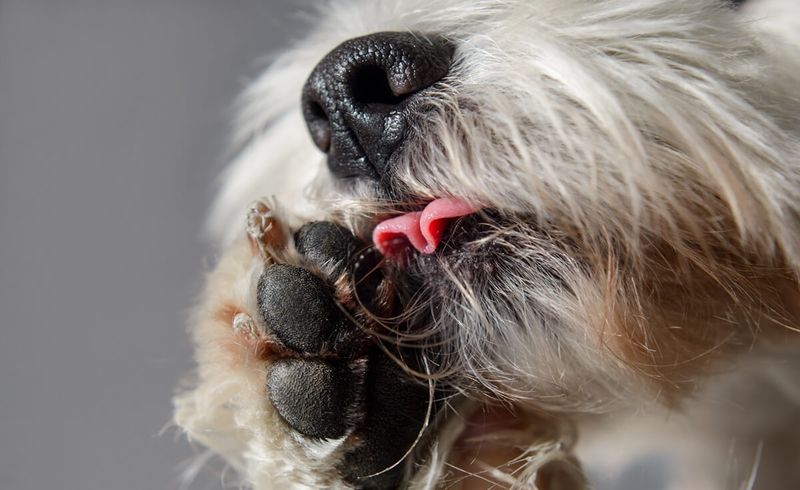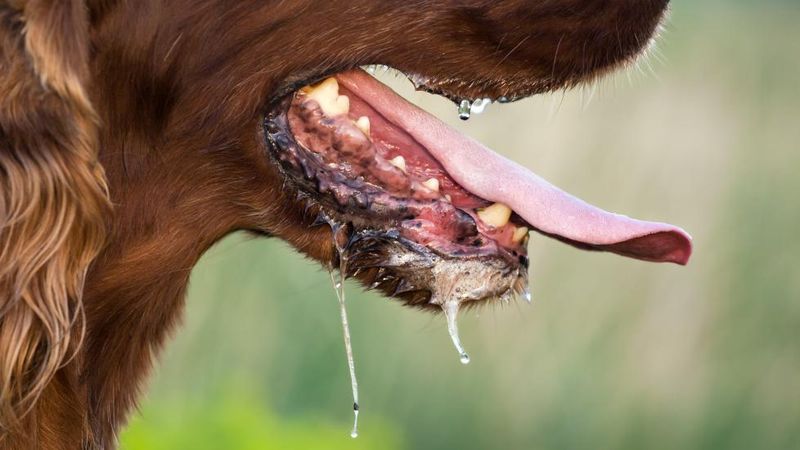Some dog behaviors aren’t quirky—they’re cries for help. That head pressed against the wall? That sudden silence from a once playful pup? They’re not random. They’re red flags. Dogs don’t speak our language, but they’re always talking. Through posture. Through pacing. Through the things they stop doing when something feels off. It’s easy to shrug off a change in mood or a strange habit. But what if your dog is quietly suffering? What if the signs have been there all along? Don’t wait until it’s too late. These 15 behaviors aren’t just sad to witness— they’re heartbreaking warnings that something much deeper could be going on.
Excessive Licking

When our furry friends start to lick excessively, it might not just be a quirky habit. It could be a sign of allergies or anxiety. Consider the story of Max, a Labrador who wouldn’t stop licking his paws. His owner discovered it was due to a pollen allergy, leading to inflamed skin. Monitoring such behavior in your dog can prevent further complications. A veterinarian’s advice can offer relief and solutions. Additionally, boredom can trigger this, so keeping your dog engaged with toys and activities might help. Understanding the root cause is key to ensuring your pet’s comfort.
Loss of Appetite

Imagine a once voracious eater suddenly ignoring their meals. The sadness in their eyes is heart-wrenching. Loss of appetite can indicate dental problems, gastrointestinal issues, or even depression. Bella, a Golden Retriever, started skipping her meals, alarming her owner. A vet visit revealed an underlying dental issue causing her discomfort. Regular dental check-ups can prevent such heartbreaks. Sometimes, changing their diet or feeding environment can reignite their interest in food. Keeping an eye on eating habits and consulting a vet is vital. Ensuring proper nutrition is essential for your dog’s health.
Aggressive Behavior

A once gentle dog turning aggressive is a cause for concern. This behavior might be a cry for help. Aggression can stem from pain, fear, or underlying health issues. Take the case of Charlie, a Border Collie, who suddenly became aggressive towards other dogs. A thorough check-up revealed arthritis causing him pain. Addressing the source of discomfort can often bring back their friendly demeanor. Professional training might also help manage aggression. Understanding that aggression is often a symptom rather than the problem itself is crucial in helping our pets.
Excessive Barking

Persistent barking can be more than a nuisance; it might be a sign that something’s wrong. It can be a result of anxiety, fear, or even a response to pain. Luna, a Poodle, started barking excessively at night, keeping her owners awake. A vet visit unveiled a thyroid issue affecting her behavior. Addressing such health concerns can restore peace. Training and environmental adjustments can also help. If your dog’s barking patterns change, it’s essential to observe them closely. Understanding their cues can alleviate both their distress and yours.
Constant Whining

Whining isn’t just a way for your dog to demand attention; it might mean they’re in distress. Whether it’s physical pain or emotional discomfort, recognizing the cause is vital. Oliver, a Beagle, started whining constantly when his owner left for work. It turned out to be separation anxiety. With professional guidance, they found strategies to ease his distress. Sometimes, medical issues like arthritis or injuries could also be the cause. Consulting a vet can provide clarity. Whining should never be ignored, as it’s a window into their emotional state.
Hiding or Cowering

Dogs that suddenly retreat to hide or cower may be signaling distress. This behavior can be indicative of fear, anxiety, or illness. Consider Daisy, a Cocker Spaniel, who started hiding under the bed. Her owner discovered she was frightened by loud construction noises nearby. Providing a safe and comforting space can help alleviate their fear. Sometimes, underlying medical issues like hypothyroidism can lead to such behavior. Professional evaluation is essential to understand the cause. Recognizing these cues can ensure your pet feels safe and secure.
Destructive Chewing

Destructive chewing can be more than a playful act; it might be a sign of stress or discomfort. When Fido, a Boxer, began chewing on furniture, it puzzled his owners. A vet identified it as a symptom of anxiety due to lack of exercise. Ensuring regular physical activity can often mitigate such behavior. Sometimes, dental issues or teething in younger dogs can also lead to destructive chewing. Providing appropriate chew toys can redirect their energy. Understanding this behavior can prevent damage and ensure your pet’s happiness.
Frequent Scratching

Frequent scratching can be distressing for both dogs and their owners. It might indicate allergies, parasites, or skin infections. Bailey, a Schnauzer, couldn’t stop scratching her ears, causing concern. A vet diagnosed her with a yeast infection. Timely intervention prevented further discomfort. Regular grooming and vet check-ups can help manage skin issues. Observing your dog’s scratching habits and seeking veterinary advice can ensure their well-being. It’s crucial to address these signs early to avoid more serious health problems. Keeping an eye on their skin condition is vital.
Restlessness or Pacing

When dogs pace or seem restless, they could be signaling discomfort or anxiety. It might be a reaction to changes in their environment or health issues. Max, a German Shepherd, started pacing at night, causing concern for his family. They discovered he was experiencing discomfort due to an undiagnosed bladder issue. Consulting a vet can help pinpoint the cause and provide relief. Sometimes, mental stimulation and exercise can also alleviate restlessness. Keeping an eye on your dog’s behavior and seeking timely advice is key to ensuring their comfort.
Drooling Excessively

While drooling is normal for some breeds, excessive drooling can indicate health issues. It might be a sign of dental problems, nausea, or even poisoning. When Cooper, a Saint Bernard, began drooling more than usual, his owner took him to the vet. They discovered an oral infection that needed treatment. Regular dental care can prevent such issues. Observing changes in drooling patterns is essential. If your dog’s drooling seems excessive, it’s wise to consult a vet. Keeping an eye on their oral health can prevent discomfort.
Sudden Weight Loss

Sudden weight loss in dogs can be alarming and often signals serious health issues. It might be due to gastrointestinal problems, parasites, or chronic illness. Lucy, a Dachshund, started losing weight rapidly, worrying her owner. A vet visit revealed a thyroid imbalance that required attention. Regular check-ups and a balanced diet can prevent such issues. Monitoring your dog’s weight and eating habits is crucial. If you notice drastic changes, seeking professional advice is wise. Ensuring your dog maintains a healthy weight is vital for their overall well-being.
Refusal to Play

When a playful dog suddenly shows disinterest in play, it might indicate underlying issues. It could be a sign of pain, depression, or fatigue. Buddy, a lively Terrier, stopped engaging with his favorite toys, causing concern. A vet identified joint pain as the culprit. Addressing such issues can reignite their playful spirit. Ensuring regular exercise and mental stimulation can prevent boredom. Sometimes, changes in routine or environment can also affect their mood. Keeping an eye on their activity levels and seeking guidance when needed is important.
Panting Excessively

While panting is normal for dogs, excessive panting can signal underlying health issues. It might indicate heatstroke, respiratory problems, or anxiety. When Rocky, a Bulldog, started panting excessively during walks, his owner grew concerned. A vet diagnosed him with breathing difficulties requiring attention. Regular vet check-ups and awareness of environmental factors can ensure safety. Providing a cool environment and avoiding strenuous activity in heat can prevent distress. Observing panting patterns and seeking timely advice is crucial. Ensuring your dog’s comfort and health is a priority.
Change in Sleeping Patterns

Dogs that suddenly change their sleeping habits might be experiencing health issues. It could be due to pain, anxiety, or underlying medical conditions. Bella, a usually energetic Dalmatian, became lethargic and slept more than usual. Her owner consulted a vet, discovering arthritis as the cause. Addressing such issues can improve their quality of life. Ensuring a comfortable sleeping area and regular vet check-ups can help. Observing changes in sleep patterns and seeking guidance can ensure your pet’s well-being. Understanding their needs is essential to their happiness.
Head Shaking

Head shaking in dogs can be more than a quirky behavior; it might indicate discomfort. It could be due to ear infections, allergies, or foreign objects. When Sparky, a Spaniel, started shaking his head frequently, his owner took notice. A vet discovered an ear infection needing treatment. Regular ear checks and cleaning can prevent such issues. Observing changes in behavior and seeking timely veterinary advice is crucial. Ensuring your dog’s ears are healthy and clean is key to their comfort. Addressing such signs early can prevent further complications.

